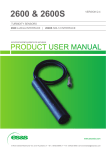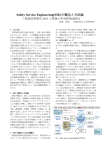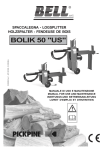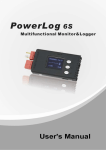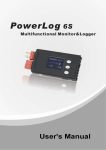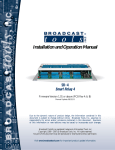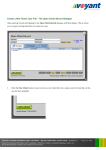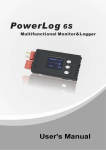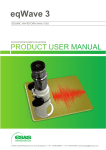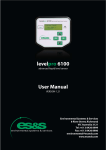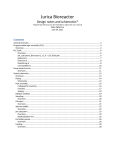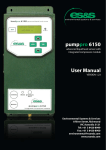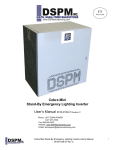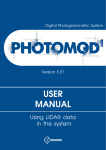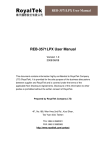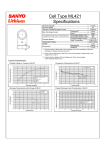Download 1500 user manual 1-7 - Environmental Systems & Services
Transcript
EC1500 ELECTRICAL CONDUCTIVITY SENSOR 1500 4-20mA output | 1500S SDI-12 interface | 1500S4 combined 4-20mA & SDI-12 www.esands.com 8 River Street Richmond VIC 3121 Australia | T + 61 3 8420 8999 | F + 61 3 8420 8900 | [email protected] ES&S Quality Assurance Statement ISO9001 accreditation ES&S is currently an AS/NZS ISO9001:2008 certified organisation. This certification is evidence that sound practices are used to get high quality instrumentation to your organization within a reasonable time interval. Standard practices are used for all areas of manufacture, beginning with the efficient procurement of incoming orders, right through to shipment. Stringent quality assurance procedures are applied to all aspects of manufacturing, including the calibration of scientific instruments against NATA traceable references. Every sensor is accompanied by a test and calibration certificate that can be used as reference information as well as evidence of sensor accuracy. Terms of Warranty The warranty covers part or complete replacement, repair or substitution of new instrumentation that has failed in part or completely within the warranty period. While every effort has been made to supply robust and user friendly instrumentation, the warranty does not cover instruments incorrectly installed, misused or operated in conditions outside those specified. The warranty does not cover shipment costs for instrumentation, installation or removal and, under no circumstances whatsoever, indirect or consequential losses caused by the failed instrumentation. ES&S believes the warranty conditions to be fair and just and in accordance with standard business practices worldwide. ES&S reserves the right to arbitrate any warranty issues and will ensure that warranty issues are treated with the highest standards of professional conduct. At ES&S we believe your investment in our products and services is a good decision and we will therefore ensure all your requirements are met at all times, both now and in the future. Contents Conductivity measurement background What is conductivity? How is conductivity measured? How does the 1500 electrical conductivity sensor work? What is temperature compensation? Sensor description Installation Site selection Site preparation Sensor installation Sensor electrical connection Operation Maintenance General Calibration check Specifications Ordering information Contact details 1500 user manual 1-7.doc 1 Background information What is electrical conductivity? Electrical conductivity is a measure of how easily an electrical current can flow through a substance. It is easily measured by low cost meters and is the inverse of resistance. Conductivity plays a major role in water quality measurement as it is a direct indicator of dissolved impurities. Pure water has extremely low conductivity (resistance of greater than 10 megaohms) meaning it allows very little electrical current to flow. As soon as impurities, in the form of dissolved salts, enter the water, resistance decreases, flow of electricity increases and therefore conductivity increases. By measuring the conductivity, the amount of dissolved solids can be easily determined. While an EC sensor cannot determine the type of dissolved salts, it can provide a good indicator of how suitable the water is for a large number of uses. For example, and EC sensor installed in a river downstream of a farming area can provide valuable information about how much the water is being contaminated by fertilizer runoff during rain events. It the same water is being used for viticultural irrigation, salt content must be low to ensure plantations are not endangered by water that is too salty. How is conductivity measured? Measuring conductivity is very straight forward. Simply place two electrical probes 1m apart into the water sample. Apply a known voltage to the probes and measure the current flowing through the probes. Using the formula V=IR, the resistance of the water sample can be determined. To convert to conductivity, take the inverse of resistance. Ie: R = V/I then Conductivity = 1/R (in Siemens or 1/ohms) For example, apply 1V to the probes (1m apart) and current flow is 0.001A, resistance is 1,000 ohms. Conductivity is 1 milliSiemens or 1,000 microSiemens For practical applications it is not desirable to use two probes 1m apart. Instead, a probe can be manufactured into a compact probe containing both electrodes. The measuring principle remains the same. How does the 1500 conductivity sensor work? The 1500 EC sensor employs a unique measuring technique. Instead of electrical contact probes, it uses an inductive (or magnetic) method to determine conductivity. Two coils are placed a known distance apart. One coil has an oscillating current applied that forms a magnetic field inside the coil centre. The other coil receives the magnetic flux produced inside the transmit coil. However, because of the coil arrangement the receiving coil will only receive signal if a conductor is placed in the middle of the coils. If water is allowed to flow through the coil centre, impurities in the form of dissolved salts will once again provide the necessary magnetic coupling. 1500 user manual 1-7.doc 2 Figure 1. EC measurement using magnetic coupling Magnetic flux is concentrated in the middle of coils. Conductive water flowing through middle increases magnetic coupling between transmit and receive coils. Figure 1. 1500 Sensor measurement principle The above diagram shows how the sensor works. Transmit (Tx) coil forms a magnetic flux inside the coil pair. Conductive water increases the magnetic coupling which is seen as a transfer of oscillating current in receiver (Rx) coil. The degree of transfer is an indication of water conductivity. What is temperature compensation? Like resistance, conductivity changes with temperature. The lower the temperature, the less the conductivity and this is because electrons find it harder to flow through dissociated salt molecules at lower temperature. This makes measurement confusing when actually trying to determine the water conductivity over a temperature range. To overcome this effect, conductivity measurements at any temperature are output as if the temperature is 25°C and is called temperature compensated output. The relationship between compensated and non compensated (raw) output is linear and simply put, a percentage is added or subtracted from the raw measurement to determine compensated output. For the 1500 EC sensor, the compensation is set at approximately 2% per °C. For temperatures below 25 °C the proportion is subtracted and is added for temperatures above 25°C. Of course the temperature needs to be measured for compensation and therefore the 1500 EC sensor has an internal temperature sensor. As an additional feature, the 1500 EC sensor also has a separate temperature output available to loggers and controllers as a 4-20mA signal. Temperature compensation operates between 0 and 50°C, the typical expected water temperature for most environmental conditions. Corrected EC @ 25ºC in uS/cm = 1500 user manual 1-7.doc Raw E.C. Reading in uS/cm 1 + 0.02 (Sample Temperature - 25ºC) 3 Sensor description Figure 2. Sensor dimensions Sensor head 8 mm 56 mm 20 mm 262 mm The 1500 sensor is a fully submersible device used for measuring water conductivity. It is constructed from durable machined plastic components and epoxy resins. For reliability, there are no wetted metal components to corrode making this sensor suitable for high conductivity (high dissolved solids) application and even for water with high acidity. The 1500 EC sensor is designed for very long term deployment at unattended monitoring stations. The sensor head is fully epoxy encapsulated and has a hole through the middle to allow the flow of water through it. It is here that the water provides magnetic coupling for the measurement to take place. An 8mm diameter submersible rated cable is hardwired to the back of the sensor (length specified during ordering). Although care must be taken to secure the sensor at all times, the sensor may be suspended from the cable for short periods such as during installation. Once installed and powered, the sensor will measure conductivity from zero to full scale, as indicated on the sensor body in microSiemens. The “dry” end of the cable has four wires for supply, ground and current output signals. Connectors can be fitted for direct connection to ES&S equipment (such as the 3500 logger) or custom connectors can be fitted upon request. There are no moving parts on the 1500 EC sensor, and no serviceable components. This sensor is a dual output 3 wire current loop device as detailed in the Installation section. 1500 user manual 1-7.doc 4 Installation Site Selection Before installing a 1500 EC sensor it is recommended a suitable site be selected first. The installation and maintenance complexity as well as the reliability of the instrument in critical applications depends on the site chosen and the length of cable required can then be determined. Well chosen sites: • slow flowing water (no stratification) • minimal or no accumulation of debris around sensor • easy and safe access, away from waterway traffic • sensor head is always submerged in at least 200mm of water • sensor head is at least 100mm from bottom and at least 50mm from any metal • sensor cannot be dislodged during high flows Avoid sites with: • very low or stagnant water flows • where debris can accumulate inside sensor head • excessive air bubbles in water • difficult or unsafe access • high siltation rates • where sensor will be exposed in air during low flows The following is also recommended for EC sensor installation • • • Install the sensor out of direct sunlight, especially when in shallow water. Sunlight will heat the sensor head to produce a false temperature and compensated EC reading. Algae will tend to grow within the sensor hole. This can be minimized by covering the sensor with a shield to make the head as dark as possible. No sunlight means no algae Silt can accumulate in the sensor hole. Install the sensor so water can flow through the hole. Typically, most sites that are already equipped with hydrographic instrumentation can be used for installation of the 1500 EC sensor. EC1500 Model Types There are three EC1500 models: • EC1500 - 4-20mA output Only • EC1500S - SDI-12 output Only • EC1500S4 - SDI-12 & 4-20mA output 1500 user manual 1-7.doc 5 Installation Orientation For correct installation the following installation restrictions apply ! ! ! >50mm >50mm flow flow " " " Figure 3. Sensor orientation With the exception of the head (with hole trough it), the rest of the sensor can be completely covered. If 50mm ID poly tube is used for installation, a suitable compression gland is available from irrigation hardware suppliers. The sensor outside diameter is smaller than the compression gland internal diameter and can be clamped easily and securely using this method. When this system is used, the sensor head must protrude from the gland by as least 60mm. Sensor Clearance Correct orientation of the sensor will help to reduce the build up of silt and debris within the hole in the center of the EC head. Where algal blooms are likely it is recommended the sensor is covered with a sun shield, keeping the sensor in the shade, thereby reducing algae buildup. When installing a shield, ensure the shield clears the sensor head by at least 50mm. The shield should ideally be installed 100mm from the sensor, and cover the sensor sufficiently from direct sunlight. A shield will also prevent excessive temperature variations. 1500 user manual 1-7.doc 6 Site preparation Before the sensor can be installed, the site must be prepared to ensure the sensor will be secured, protected and serviceable. The following recommendation is based on typical installation methods practiced by today’s hydrographers. Several variations of this method are used to suit particular applications. Please study the diagram below. Site preparation involves the installation of a larger plastic tube along the waterway bank as shown. The tube should ideally be continuous but may also be made from sections. One end of the tube must be installed into the water ensuring the sensor optical path will not be obstructed according to the previous section Sensor Clearance. The other end can be terminated in a junction pit that is large enough so that the sensor can be inserted from the pit. Typically, an underground electrical pit is used as this also allows a sensor carrier assembly to be inserted easily. The pit must be installed on a stable part of the bank that cannot erode. Site shelter Figure 5. Sensor installation Junction pit Sensor tube with sensor installed at end. See detail. A waterway waterway bank Detail A Guide tube. Sensor is strapped to side of tube. Optional guide disks – made from plastic Cable tie or similar devices Figure 6. Sensor installation 1500 user manual 1-7.doc 7 EC1500 Model Types EC1500 4-20mA The diagram below shows the electrical circuit equivalent of a 4-20mA output 1500 EC sensor. +12 volts dc The 1500 EC sensor has two, 3 wire current loop devices EC out 4-20mA load (RL ) Common load (RL ) Temp out 4-20mA Figure 7. EC1500 4-20mA electrical equivalent circuit A single cable is hardwired to the 1500 sensor. The diagram below shows the configuration and typical connection of the sensor to power and controlling equipment. switched +12Vdc 4-20mA EC out 4-20mA temperature out not used common (0V) Figure 8. EC1500 4-20mA conductor designation The EC1500 Sensor is used in 4-20 mA mode only, the Green wire is not required & the Blue and Yellow wires are EC and Temperature 4-20 mA outputs. The red wire is 12V power and the black wire is Gnd. Conductor Colour red blue black yellow green Conductor Designation switched +12vdc input 4-20mA output, EC common 4-20mA output, Temp Not used 1500 user manual 1-7.doc Requirement 80 mA Source current 0V Source current ES&S 3-pin A B C B (plug 2) ES&S 5-pin A B C D E 8 EC1500S SDI-12 +12 volts dc The EC1500S sensor is an SDI-12 sensor SDI-12 SDI I/O Gnd Figure 9. EC1500S electrical equivalent circuit A single cable is hardwired to the 1500 sensor. The diagram below shows the configuration and typical connection of the sensor to power and controlling equipment. switched +12Vdc not used not used SDI-12 in/out common (0V) Conductor Colour Red Blue Black Yellow Green Conductor Designation switched +12vdc input Not used common Not used SDI-12 in/out 1500 user manual 1-7.doc Requirement 80 mA typ 0V SDI data ES&S 3-pin A B C B (plug 2) ES&S 5-pin A B C D E 9 EC1500S4 Combined SDI-12 and 4-20mA sensor electrical connection +12 volts dc SDI-12 SDI I/O EC out 4-20mA The EC1500S4 is an SDI-12 sensor plus two 3 wire current loop devices load (RL ) Common load (RL ) Temp out 4-20mA Figure 11. EC1500S4 electrical equivalent circuit switched +12Vdc 4-20mA EC out 4-20mA temperature out SDI-12 in/out common (0V) Conductor Colour red blue Conductor Designation switched +12vdc input 4-20mA output, EC black yellow Common 4-20mA output, Temp green SDI-12 in/out Requirement 80mA min Source, max 120! load Note: 1 0V dc Source, max 120! load Note: 1 ES&S 3-pin A B ES&S 5-pin A B C B (plug 2) C D E Note: 1 The 4-20mA output of the EC1500S4 MUST have a load resistor of 0 – 120R. If the 4-20mA output is not used, connect the blue and yellow wires to common. 1500 user manual 1-7.doc 10 1500 4-20mA Interface EC1500 and EC1500S4 To obtain a measurement from the 1500 sensor: " " " " Install the sensor according to recommendations in Section Installation. Apply power to the sensor 1500: 2 x 4-20mA current output will be produced at the respective outputs. 1500S: Conductivity data is available on the SDI-12 bus A current output signal will be available for measurement after 1 second. For power conserving applications, the sensor can be switched off immediately after the reading is attained. The sensor can also be left on continuously if required. The 4-20mA current output will be available for reading 1 second after switched power is applied. With proper care and routine maintenance, the sensor can be left operating unattended for several months. Of course, as each application will be different, it is recommended that the total time between services is determined experimentally. 1500S SDI-12 Interface EC1500S and EC1500S4 The SDI-12 interface of the EC1500S and EC1500S4 handles all of the communication and power down features of the SDI-12 protocol. All standard SDI-12 commands are supported. In addition, extended commands can be used to calibrate sensor outputs. Each of the measurements can be scaled and offset with user supplied calibration coefficients. The factory sets these parameters so the output is in !S/cm. Any changes to these parameters should take into account their factory calibration values as these have been established by measurement for each sensor. The SDI-12 Interface also has an on board temperature sensor. The interface has been fully tested with the NR Systems SDI-12 Verifier. Note that the EC1500S1and EC1500 S4 are 11 cm longer than the 4-20mA EC1500. Note that some of the earlier EC1500S had an SDI-12 interface with the output data scaled 4-20. 1500 user manual 1-7.doc 11 SDI-12 Commands The commands assume that the sensor address is 0, but any address could be substituted into the commands below. "\r\n" is carriage return and line feed characters. Calibration coefficients are modified by extended "X" commands, and are indexed by a 2 dimensional array, where the first zero based index is the measurement index, and the second is the parameter. Measurement Sensor 1 Sensor 2 Sensor 3 Temperature Index 0 1 2 3 Each measurement has 3 parameters: Parameter Offset scalar resistor gain Index 0 1 2 Default Value 0.0 1.0 (Rs+Rp)/Rp Example: To calibrate the output of the second sensor such that it's voltage is multiplied by 2 and an offset of 3 is added to the result using the following transfer function: out= 2*x+3, the following two extended commands would be used: 0XSET VAR[1,0]=3! 0XSET VAR[1,1]=2! 1500 user manual 1-7.doc 12 SDI-12 Command Table Command Description Returns address of a single sensor on the SDI-12 ?! bus 0! Ping, returns same address Verify command. Subsequent 0D0! command 0V! will return the version of the Interface Begin a measurement. Subsequent 0D0! 0M! command will return the 3 measurements and the temperature. Begin a measurement and respond with CRC on 0MC! subsequent 0D0! command. Begin a concurrent measurement. (Same as 0M! 0C! command but no service request is issued.) Begin a concurrent measurement and respond 0CC! with CRC on subsequent 0D0! command. Get data is called after a 0M!, 0MC!, 0C!, 0CC!, and 0V! commands. If called after the 0V command then the single result is the version 0D0! number, otherwise it returns 4 results, namely the 3 sensor voltages, and the internal temperature of the interface. Set and store one of the calibration coefficients 0XSET indexed by m,p, where m is the measurement, VAR[m,p]=VAL! and n is the parameter Retrieve and store the calibration coefficients 0XLOAD indexed by m,p, where m is the measurement, VAR[M,N]! and n is the parameter, to a string buffer ready to be retrieved by the 0XGET command. Retrieve the string buffer that was filled from the 0XGET! previous 0XLOAD command Typical Response "0\r\n" "0\r\n" "00001\r\n" "00034\r\n" "00034\r\n" "00034\r\n" "00034\r\n" Response to 0V! "0+2.0\r\n" , Otherwise: "0+1.1+2.2+3.3+25.0\r\n" "0XACK\r\n" "0XACK\r\n" "0X +1.1\r\n" If no error: "0XOK\r\n" Possible errors: 0XER! Retrieve a string for the last error generated by the use of an X command. "0XER BAD COMMAND\r\n" "0XER BAD MEASUREMENT INDEX\r\n" "0XER BAD COEF INDEX\r\n" Internal Temperature Sensor Models EC155S and EC1500S4 have an internal temperature sensor, however for higher accuracy it must be calibrated by the end user 1500 user manual 1-7.doc 13 Example program to read SDI-12 The following program can be used with the Campbell Scientific CR1000 logger. Program name: CR1000 sample display reading.CR1 'Date written: 3/06/2009 using the CRBasic programming tool from ' Campbell Scientific LoggerNet 3.4.1 'This program is used to test the SDI-12 Interface using a 'Campbells CR1000 logger. ' 'Sensor powered from 12V terminal and a G terminal, and with SDI-12 'on C1 terminal. ' Logger C1----green-------Sensor SDI-12 ' 12V --red--------Sensor Power +ve ' G ----black------Sensor Ground 'The program below will collect data each second from the four SDI-12 'Interface channels. 'Use one of the Data Displays from the loggerNet Connect Screen. 'Set the table cells to sdidata(1) to sdidata(4). 'The information from each of the four channels of the SDI-12 Sensor 'Engine will be displayed and updated every second. Public sdidata(4) 'sdidata(1) 'sdidata(2) 'sdidata(3) 'sdidata(4) conductivity temperature not used temperature of SDI IF uprocessor BeginProg Scan(1,Sec, 3, 0) SDI12Recorder(sdidata, 1, "0", "M!", 1.000, 0) NextScan EndProg 1500 user manual 1-7.doc 14 Maintenance The 1500 sensor will require little periodic maintenance to ensure that measurements remain accurate. While all wetted components are no metallic and cannot corrode in high salt or acidity liquids. Debris, silt and algae lodged in the hole can cause inaccurate readings. It is recommended the sensor is checked during every visit, or at least every 3-6 months. You may find the sensor will not require any maintenance for even longer periods however, warmer climates or high silt laded rivers and streams can accelerate these effects.. General " Ensure the sensor is not affected by debris, silt or algae (or marine growth). The sensor should be removed from its installed location for a thorough inspection. Using the recommended installation method outlined in the section Installation, removal should be easy and maintenance staff do not need to enter the waterway " Ensure the installation is sound and the sensor is still secure from moving and there are no obvious signs of erosion or damage. Calibration check The sensor output can be checked against a reference instrument if it is available. Ideally, the measurement should be taken in the same solution as the sensor while the sensor is installed. If there is a large difference, an installation problem may be highlighted. All sensor measurements should be within the specified accuracy. " compare the sensor measurement to that of the reference instrument. " ensure the reference instrument calibration error is also known. 1500 user manual 1-7.doc 15 Specifications Range Standard ranges of 500, 1000, 2000, 5000, 10000, 20000, 50000, 60000 uS/cm. Other ranges available on request. Accuracy EC: Linearity < 3% of full scale Temperature < 0.2%/ °C of FS over the range 0 to 30 °C. Temperature range -10 to 60 °C storage, operating: 0 to 50 °C Zero & Full Scale Setting +/- 0.1% of full scale setting Response Time 2 seconds to full accuracy Type Magnetic inductive coupling SDI-12 Output EC in uS/cm (standard) The SDI-12 output of the EC1500S and EC1500S4 can also be scaled at the factory to read 4-20. Check with factory. 4-20mA Output Scaled to maximum range. 1500 Analogue 1500S/S4 Scaled SDI-12 Example for 20000uS/cm probe: 4-20mA current 4-20 In general, the transfer function is: Conductivity = Cm(R-4) uS/cm, where Cm = Max range, R=reading 16 So, for Cm=20000uS/cm: Conductivity = 1250(R-4) uS/cm Power Supply 10-15 V unregulated, current capability >500mA 0.3mAh per reading on average (typical) Surge Secondary surge protection, Can absorb 0.6J of energy Dimensions 1500: 262 long,56 dia (mm) 1500S/S4: 240 long,46 dia + 106 long, 56 dia (mm) 1500 user manual 1-7.doc 16 Ordering information Item description code Electrical conductivity sensor 1500 Cable, hardwired to sensor, 10 meters std (other cable length available on request) 1510 Connector, 2 x 3 pin male plugs fitted to 1510 cable with “V” splice to sensor cable 1520 Connector, 5 pin male plug fitted to 1510 cable 1530 Extension cable with 5 pin male plug and 5 pin female jack, meters 1540 Note: For EC with SDI-12 output, add “S” to the above ordering codes. Example: SDI-12 Electrical conductivity sensor: 1500S Contact Details Environmental Systems & Services Pty. Ltd. Address: 8 River Street Richmond, Victoria, 3121 Australia PO Box 939 Hawthorn, Victoria, 3122 Phone: Fax: 03 8420 8999 03 8420 8900 Int’l phone: +61 3 8420 8999 Int’l fax: +61 3 8420 8900 email: web: [email protected] www.esands.com 1500 user manual 1-7.doc 17
























